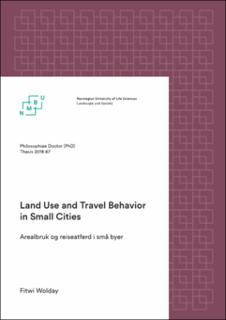| dc.description.abstract | Research on the relationship between land-use and travel behavior has been at the forefront of finding solutions to the ever-growing challenges of energy demand and urban pollution associated with transportation. However, much of the research has been focused on medium-to-large cities. Since relationships between built environment and travel behavior are geographically contextualized, the extent of influence of built environment on travel is contingent on geographic context. As a result, the effect of policy-relevant built environment factors are likely to vary between cities of different sizes.
Small cities accommodate a sizable share of national populations (e.g. 28 % in Norway). Small city residents are largely car dependent, often with long driving distances and low shares of active travel. A serious effort attempting to promote sustainable mobility cannot do so without properly understanding what shapes travel behavior in small cities at both local and regional scale. To contribute in filling the knowledge gap and inform small-city planners on their quest for sustainable mobility, this thesis focuses on the relationship between built environment and travel behavior in a small-city context.
The overarching research question of the thesis is: which built environment attributes and transport strategies can best serve the goal of sustainable mobility in a small city context? This main question was addressed by formulating a number of researchable questions addressed in the four articles included in the thesis.
The four articles fall under three main research themes. The aim of the first research theme is to investigate the significance of travel attitude as a source of bias in land-use and transportation research. Its purpose in the thesis is to inform the succeeding two research themes on how to model travel attitudes in travel behavior research. The second research theme investigates the influence of neighborhood, local (city scale) and regional built environment factors on car driving distance in a small city context. The third research theme focuses on so-called active transport (walking and biking) and investigates the relationship between built environment and active transport at the neighborhood as well as city scale in small cities.
The role of attitudes towards active transport is given special attention in the last theme. In modeling active transport, travel attitude is included not as a control variable but as a variable of prime interest due to its direct effect on motivation to active transport. The modeling framework is inspired by ecological models and informed by lessons from the first research theme.
Survey data from three small cities in the southeastern part of Norway are used to answer the research questions. In addition, the small-cities’ data is supplemented by data from Oslo metropolitan area, which is specifically used to address the issue of travel-induced residential self-selection. With the exception of the first article, where mixed-methods approach (combining quantitative and qualitative methods) was used, the thesis employed mainly quantitative methods of analysis in investigating the effect of the built environment on motorized and non-motorized travel behavior.
The main conclusions of the study underscore that regional context is important to understand how and to what extent residential location affects travel behavior in a small city context. In a city such as Kongsvinger, where regional pull-factors from a nearby higher-order city is weaker, living close to the center of the small city significantly reduces total car driving distance. In cities with proximity to a higher-order city, the influence of residential distance from the city center on driving distance is weaker and likely mediated by transit commutes due to higher propensity among commuters working in the larger city to commute by transit if they live close to the center of the small town. Among the demographic and socio-economic characteristics, gender has an influence in all three cities, with men tending to drive longer distances than women do. The influence of income and employment are strongest in the cities that are most strongly integrated into the labor market of the Oslo region.
Regarding the relationship between built environment and active transport behavior in small cities, attitude towards active travel is found to exert the strongest influence on the propensity to bike/walk. Neighbourhood-level accessibility to facilities is also important but its influence varies by trip purpose (facility type). For trips to grocery stores, availability of such stores in the neighborhood is highly influential whereas for more specialized stores and facilities (center facilities), concentration of facilities close to the city center is more strongly associated with a high frequency of walk/bike trips. Topography also influences the likelihood of traveling by active modes, irrespective of destination type, for example by reducing the frequency of walking and biking trips among residents of hilly neighborhoods.
Three main recommendations with implications for urban planning policies can be drawn from this thesis. First, planners should avoid measures that lead to sprawling of center facilities, for example, shopping centers at city fringes. Second, since grocery stores accessible at a neighborhood scale increase the propensity of active travel, new residential areas should be developed in such a way that the population base for neighborhood facilities such as grocery stores is sufficiently high. Third, the analysis also reveals that attitude towards active travel exerts strong influence on people’s tendency to travel by non-motorized modes. Therefore, awareness campaigns to sway individual and community attitudes coupled, for example, with incentives to the adoption of electric bikes in order to reduce the level of exertion associated with topographical contours may likely boost walk/bike frequency. | en_US |

